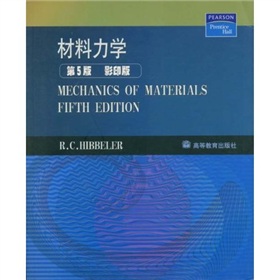材料力学 》》 电子书下载 PDF下载

内容简介
《材料力学》重视基本概念、基本理论与基本方法的讲述,思路清晰,层次分明,既简明易懂,又论述严谨。全书选编了211个例题,通过这些例题,许多解题的方法与技巧,得到了具体而生动地揭示,提高了学生分析问题的能力。许多节的后面,均安排了“重点”与“分析方法”,这些提示对主要概念、理论与方法进行了高度概括,论述精要,对学生学习有很大的帮助。《材料力学》第1与第2章分别讲述应力与应变的概念。第3章介绍材料的力学性能。第4,5与第6各章分别论述构件在轴向加载、扭转与弯曲时的应力与变形,涵盖线弹性与非弹性,涉及应力集中与残余应力。第7章研究梁横向剪切时的应力,包括薄壁梁的剪流与剪心。第8章讨论组合载荷问题。第9与第1O章分别讲述应力与应变的变换,在第10章还介绍了失效理论。第11章介绍梁与轴的设计,第12章研究梁与轴的位移。第13章讲述柱的稳定性。第14章讲述能量法,包括虚功原理、单位载荷法、卡氏定理与冲击载荷问题。关于截面的几何性质则集中在附录A给出。《材料力学》是一本优秀教材,其内容与我国当前高等工科院校材料力学的教学要求也相当接近,《材料力学》既可作为进行双语教学材料力学课程的基本教材,也可作为学习材料力学课程的主要参考书。
目录
PREFACE
1 Stress
1.1 introduction
1.2 equilibrium of a deformablebody
1.3 stress
1.4 average Norrnal stress in an axialy loaded bar
1.5 averge shear stress
1.6 allowabil stress
2 Straln
2.1 deformation
2.2 strain
3 mechanical properties of materials
3.1 the tension and compression test
3.2 the stress-stian diangram
3.3 stress-strain behavior of ductile and brittle materials
3.4 hokes law
3.5 strain energy
3.6 poissons ratio
3.7 the shear stress-strain diagram
3.8 failure of materials due to creep and fatigue
4 axial load
4.1 saint-venants principle
4.2 elastic deformation of an axially loaded member
4.3 principle of superposition
4.4 statically indeterminate axially loaded member
4.5 the forcemethod of analysis for axially loaded members
4.6 thermal stress
4.7 stress concentrations
4.8 inelastic axial deformation
4.9 residual stress
5 torsion
5.1 torsional deformation of a circular shaft
5.2 the torsion formula
5.3 power transmission
5.4 angle of twist
5.5 statically indeterminate torque-loaded members
5.6 solid noncircular shafts
5.7 thin-walled tubes having closed cross section
5.8 stress concentration
5.9 inelastic torsion
5.10 residual sress
6 bending
6.1 shear and moment diagrams
6.2 graphical method for constructing shear and moment diagrams
6.3 bending deformation of a straight member
7 TRANSVERSE SHEAR
7.1Shear in Straight Members
7.2The Shear Formula
7.3Shear Stresses in Beams
7.4Shear Flow in Built.up Members
7.5Shear Flow in Thin-Walied Members
7.6Shear Center
8 COMBINED LOADINGS
8.1 Thin.Walled Vessels
8.2 State of Stress Caused by Combined Loadings
9 STRESS TRANSFORMATION
9.1 Plane.Stress Transformation
9.2General Equations of Plane.Stress Transformation
9.3 Principal Stresses and Maximum In.Plane Shear Stress
9.4Mohr’S Circle——Plane Stress
9.5Stress in Shafts Due to Axial Load and Torsion
9.6Stress Variations Throughout a Prismatic Beam
9.7Absolute Maximum Shear Stress
STRAIN TRANSFORMATION
10.1 Plane Strain
10.2General Equations of Plane.Strain Transformation
10.3Mohr’S Circle——Plane Strain
10.4Absolute Maximum Shear Strain
10.5Strain Rosettes
10.6Material.Property RelatiOnshiDs5
10.7 Theories of Failure
11 DESIGN OF BEAMs AND SHAm
11.1 Basis for Beam Design
11.2 PrismaticBeamDesign
1 1.3 Fully Stressed Beams
11.4 Shaft Design
12 DEFLECTIONS OF BEAMMS AND SHAFIS
12.1The Elastic Curve
12.2Slope and Displacement by Integration
12.3 Discontinuity Functions
12.4Slope and Displacement by the Mome-Area Method
12.5Method of Superposition
12.6Statically Indeterminate Beams and ShaftS
12.7Statically Indeterminate Beams and Shafts-Method of Integration
12.8SmticzUy Indeterminate Beams and Shafts Moment-Area Method
12.9Statically Indeterminate Beams and Shaft-Method of Superposition
13 BUCKLING OF COLUMNS
13.1critical Load
13.2 IdealColumnwithPin Supports
13.3 Columns Having Various Types of Supports
13.4 The Secant Formula
13.5Inelastic BucHing
13.6 Design of Columns for Concentric Loading
13.7 Design of Columns for Eccentric Loading
14 energy methods
A geometric properties of an area
B geomedtrical proprrties of structural shapes
C slopes and deflections of beams
D review for the fundamentals of engineering exam
answers
index
1 Stress
1.1 introduction
1.2 equilibrium of a deformablebody
1.3 stress
1.4 average Norrnal stress in an axialy loaded bar
1.5 averge shear stress
1.6 allowabil stress
2 Straln
2.1 deformation
2.2 strain
3 mechanical properties of materials
3.1 the tension and compression test
3.2 the stress-stian diangram
3.3 stress-strain behavior of ductile and brittle materials
3.4 hokes law
3.5 strain energy
3.6 poissons ratio
3.7 the shear stress-strain diagram
3.8 failure of materials due to creep and fatigue
4 axial load
4.1 saint-venants principle
4.2 elastic deformation of an axially loaded member
4.3 principle of superposition
4.4 statically indeterminate axially loaded member
4.5 the forcemethod of analysis for axially loaded members
4.6 thermal stress
4.7 stress concentrations
4.8 inelastic axial deformation
4.9 residual stress
5 torsion
5.1 torsional deformation of a circular shaft
5.2 the torsion formula
5.3 power transmission
5.4 angle of twist
5.5 statically indeterminate torque-loaded members
5.6 solid noncircular shafts
5.7 thin-walled tubes having closed cross section
5.8 stress concentration
5.9 inelastic torsion
5.10 residual sress
6 bending
6.1 shear and moment diagrams
6.2 graphical method for constructing shear and moment diagrams
6.3 bending deformation of a straight member
7 TRANSVERSE SHEAR
7.1Shear in Straight Members
7.2The Shear Formula
7.3Shear Stresses in Beams
7.4Shear Flow in Built.up Members
7.5Shear Flow in Thin-Walied Members
7.6Shear Center
8 COMBINED LOADINGS
8.1 Thin.Walled Vessels
8.2 State of Stress Caused by Combined Loadings
9 STRESS TRANSFORMATION
9.1 Plane.Stress Transformation
9.2General Equations of Plane.Stress Transformation
9.3 Principal Stresses and Maximum In.Plane Shear Stress
9.4Mohr’S Circle——Plane Stress
9.5Stress in Shafts Due to Axial Load and Torsion
9.6Stress Variations Throughout a Prismatic Beam
9.7Absolute Maximum Shear Stress
STRAIN TRANSFORMATION
10.1 Plane Strain
10.2General Equations of Plane.Strain Transformation
10.3Mohr’S Circle——Plane Strain
10.4Absolute Maximum Shear Strain
10.5Strain Rosettes
10.6Material.Property RelatiOnshiDs5
10.7 Theories of Failure
11 DESIGN OF BEAMs AND SHAm
11.1 Basis for Beam Design
11.2 PrismaticBeamDesign
1 1.3 Fully Stressed Beams
11.4 Shaft Design
12 DEFLECTIONS OF BEAMMS AND SHAFIS
12.1The Elastic Curve
12.2Slope and Displacement by Integration
12.3 Discontinuity Functions
12.4Slope and Displacement by the Mome-Area Method
12.5Method of Superposition
12.6Statically Indeterminate Beams and ShaftS
12.7Statically Indeterminate Beams and Shafts-Method of Integration
12.8SmticzUy Indeterminate Beams and Shafts Moment-Area Method
12.9Statically Indeterminate Beams and Shaft-Method of Superposition
13 BUCKLING OF COLUMNS
13.1critical Load
13.2 IdealColumnwithPin Supports
13.3 Columns Having Various Types of Supports
13.4 The Secant Formula
13.5Inelastic BucHing
13.6 Design of Columns for Concentric Loading
13.7 Design of Columns for Eccentric Loading
14 energy methods
A geometric properties of an area
B geomedtrical proprrties of structural shapes
C slopes and deflections of beams
D review for the fundamentals of engineering exam
answers
index
同类热门电子书下载更多
- 西方语言学原版影印系列丛书17:英语语言史社会语言学研究
- 大唐狄公案
- Aspen美国法学院教材系列:公司法
- 社会学经典教材影印丛书:社会学理论的结构
- 莎士比亚作品解读丛书·英文影印插图版:第十二夜
- 国际商务精选教材:国际商务基础
- 国外优秀信息科学与技术系列教学用书:程序设计语言概念
- 金融工程和计算: 原理数学算法
- 周易
- 研究生前沿教材书系:复杂性和临界状态
- 阿登版莎士比亚:威尼斯商人
- 莎士比亚作品解读丛书·英文影印插图版:罗密欧与朱丽叶
- 国外语言学与应用语言学人大版影印文库:语言与心智
- 剑桥英语等级考试系列:剑桥第一证书英语考试教程1
- 教育学经典教材:教育管理学
- 海外优秀数学教材系列丛书:概率论与数理统计
- 国外物理名著系列10`磁性量子理论:材料的磁学性质
- 美国著名医学院校教材系列:病史和查体
- Lewin细胞生物学
- 宋诗纪事补订:手稿影印本
Copyright © 2024 by topbester.com.
All Rights Reserved.
沪ICP备14027842号-1
All Rights Reserved.
沪ICP备14027842号-1